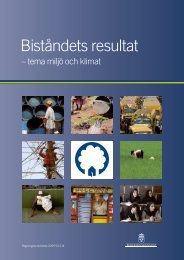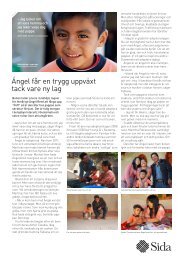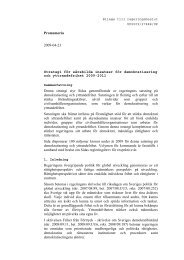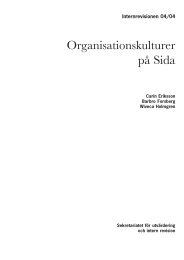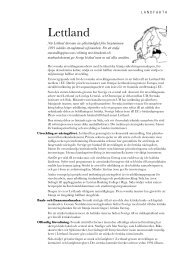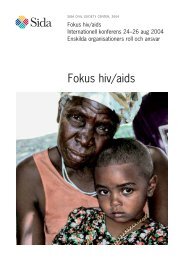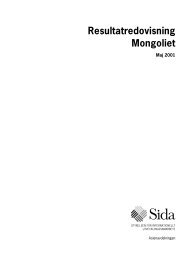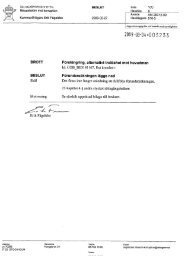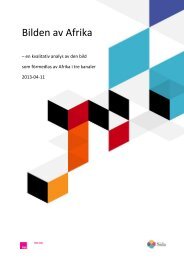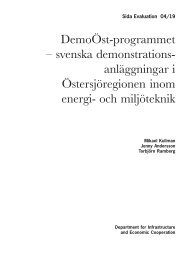Mobilisation of the Poor – a means to Poverty Reduction? - Sida
Mobilisation of the Poor – a means to Poverty Reduction? - Sida
Mobilisation of the Poor – a means to Poverty Reduction? - Sida
You also want an ePaper? Increase the reach of your titles
YUMPU automatically turns print PDFs into web optimized ePapers that Google loves.
Background <strong>to</strong> <strong>the</strong> final evaluation<br />
As <strong>Sida</strong> support for CAP came <strong>to</strong> an end in 1998, a decision was made by <strong>Sida</strong>, in consultation<br />
with RDTRI, <strong>to</strong> commission a final evaluation. In view <strong>of</strong> <strong>the</strong> long duration <strong>of</strong> <strong>the</strong> project and <strong>the</strong><br />
challenges <strong>of</strong> evaluating a project <strong>of</strong> this nature (see later in this chapter), <strong>the</strong> proposed evaluation<br />
was carried out in two phases, CAP I and CAP II.<br />
Assessments under CAP I were expected <strong>to</strong> both generate preliminary findings about CAP<br />
outcomes and formulate guidelines for more rigorous investigations, including field research <strong>to</strong> be<br />
carried out in CAP II.<br />
CAP I was carried out from March <strong>to</strong> April 2000 by a team consisting <strong>of</strong> a sociologist and an<br />
economist, both Sri Lankan. This involved a literature review, key informant interviews with<br />
selected CAP leaders, and preliminary field visits <strong>to</strong> a number <strong>of</strong> CAP sites. The CAP I findings<br />
were discussed in May 2000 with an audience consisting <strong>of</strong> RDTRI staff, various workers and<br />
consultants associated with CAP, policymakers, researchers and representatives <strong>of</strong> <strong>Sida</strong> (Silva and<br />
Gunatilake 2000). The findings, including recommendations for CAP II, were discussed both in<br />
<strong>Sida</strong>/S<strong>to</strong>ckholm and in Sri Lanka <strong>to</strong> determine a strategy for CAP II. Ano<strong>the</strong>r workshop was<br />
arranged in November 2000 in RDTRI Colombo, where an LFA-type exercise was conducted with<br />
<strong>the</strong> participation <strong>of</strong> a consultant from Sweden <strong>to</strong> clarify <strong>the</strong> reasons for pursuing CAP II and <strong>to</strong><br />
decide what approaches would be used <strong>to</strong> make it relevant <strong>to</strong> <strong>the</strong> primary stakeholders, including<br />
CAP members and leaders, RDTRI, and o<strong>the</strong>r relevant agencies in Sri Lanka and <strong>Sida</strong>.<br />
CAP II was carried out from March <strong>to</strong> July 2001 by a team consisting <strong>of</strong> a sociologist,<br />
micr<strong>of</strong>inance/enterprise development specialist and a gender specialist, again all Sri Lankan. An<br />
inception report outlining <strong>the</strong> scope, objectives and methodology <strong>of</strong> CAP II was discussed with<br />
selected stakeholders, researchers and o<strong>the</strong>r interested parties in a workshop held in RDTRI in<br />
April 2001 (see TOR, Annex 1). A similar workshop was held in Pilimatalawa RDTRI Centre in<br />
April 2001 <strong>to</strong> secure <strong>the</strong> views <strong>of</strong> CAP beneficiaries about <strong>the</strong> issues <strong>to</strong> be investigated. Both CAP I<br />
and II were conducted in a participa<strong>to</strong>ry manner taking in<strong>to</strong> consideration <strong>the</strong> views <strong>of</strong> different<br />
stakeholders at various stages <strong>of</strong> <strong>the</strong> evaluation from identifying <strong>the</strong> issues <strong>to</strong> be investigated <strong>to</strong><br />
analysing <strong>the</strong> findings. In keeping with this approach <strong>the</strong> preliminary findings <strong>of</strong> CAP II were<br />
discussed with a group <strong>of</strong> different stakeholders, including some <strong>of</strong> <strong>the</strong> original CAP architects, in a<br />
workshop held in RDTRI on July 23, 2001.<br />
This report syn<strong>the</strong>sises <strong>the</strong> findings <strong>of</strong> CAP II, taking in<strong>to</strong> consideration <strong>the</strong> preliminary findings <strong>of</strong><br />
CAP I and <strong>the</strong> feedback received from various stakeholders at different consultative meetings.<br />
Scope <strong>of</strong> CAP II<br />
The overall aim <strong>of</strong> CAP II was <strong>to</strong> assess how successful CAP was in reaching <strong>the</strong> twin goals <strong>of</strong><br />
empowering <strong>the</strong> poor, including women, and poverty alleviation. While CAP must be assessed in its<br />
proper his<strong>to</strong>rical and policy context (see Chapter Two), for logistics reasons this evaluation focuses<br />
particularly on developments since 1987. This enables us <strong>to</strong> evaluate <strong>the</strong> progress made by CAP<br />
during <strong>the</strong> time <strong>Sida</strong> was <strong>the</strong> primary donor. This covers <strong>the</strong> period during which <strong>the</strong> geographical<br />
and population coverage <strong>of</strong> CAP rapidly expanded and poverty alleviation became an explicit<br />
objective.<br />
In particular this evaluation focuses on <strong>the</strong> mobilisation <strong>of</strong> <strong>the</strong> poor through a group process that<br />
worked up from small groups formed through CAP interventions.<br />
8<br />
MOBILISATION OF THE POOR <strong>–</strong> A MEANS TO POVERTY REDUCTION <strong>–</strong> <strong>Sida</strong> EVALUATION 02/08




